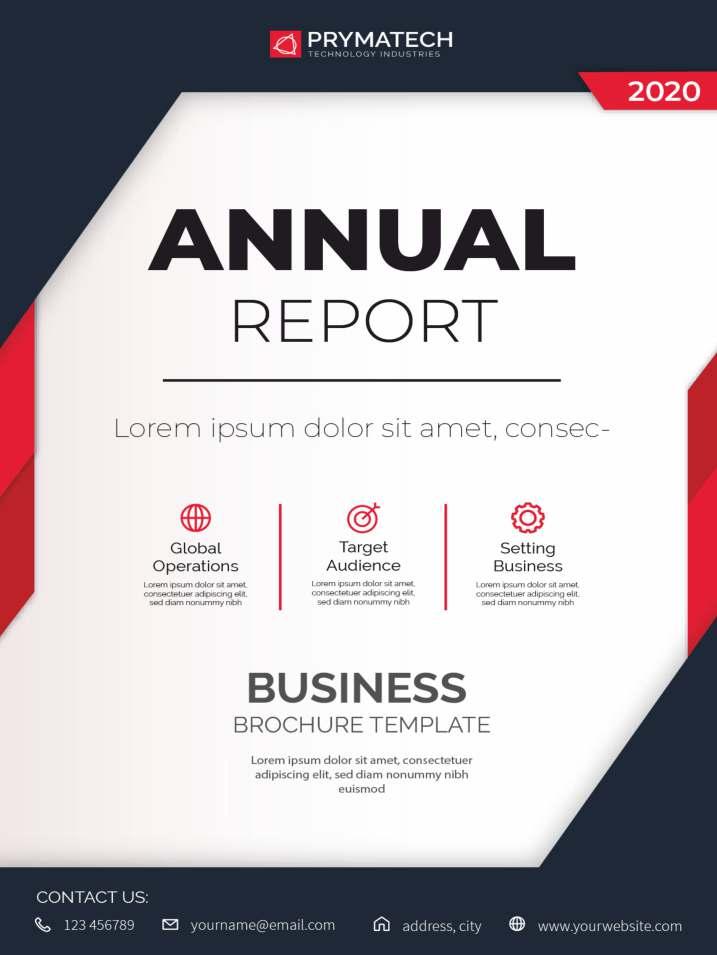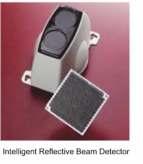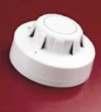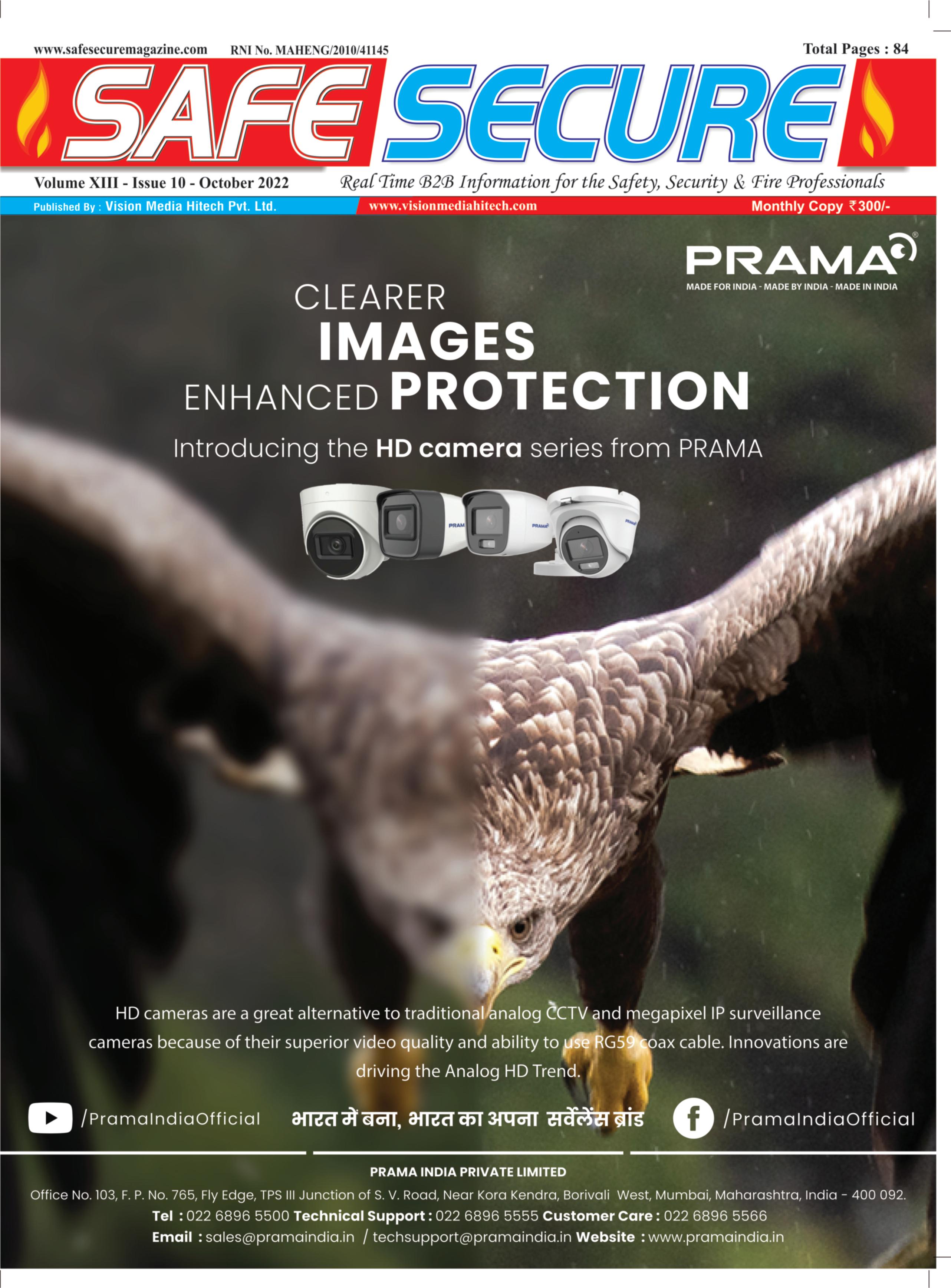

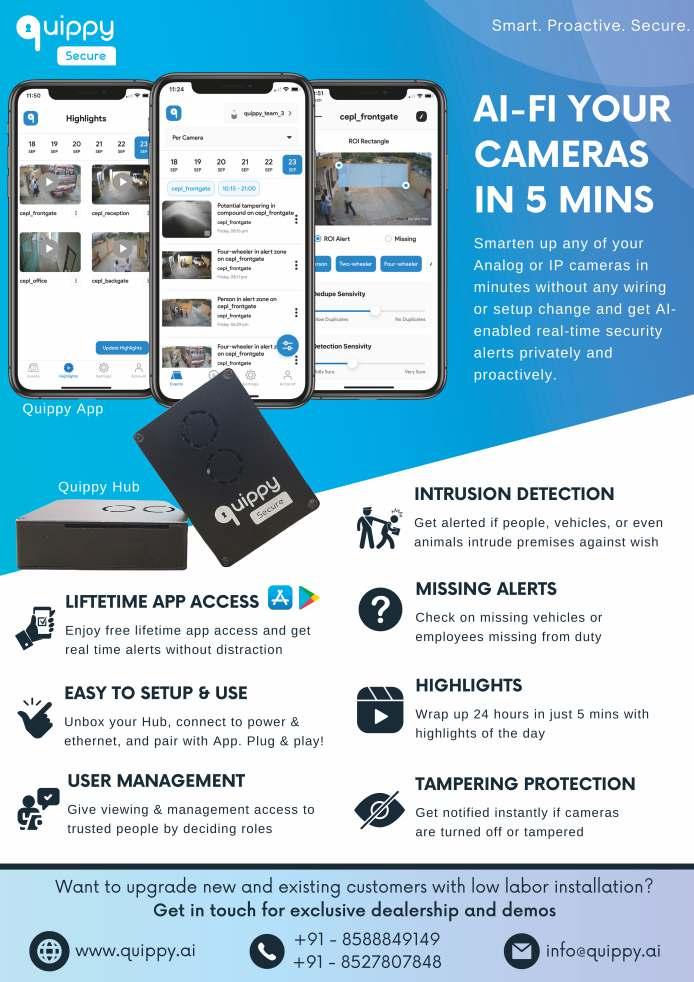





Primarily, we all should be aware of the term environment. All living things survive within their own favourable zones of the environment - thus the environment is not something that can be neglectedeasilywithoutcaringforit.Indeed,theLordcreatedaflexibilityintheenvironmentfor alloforganismsexistingonEarth.Althoughtheenvironmentcancontinuetosurviveinitsnatural state, human intervention has caused extensive destruction in many ecosystems. It is very important for us to protect our environment, so that we can continue to live on this planet - in a healthyandsafeatmosphere.
We should have to protect the environment not for only living creatures, but for the plants and treesthat provideeven morebenefits to us directly- theyprovideus withoxygenwhichweneed to breathe. Industrial and developed countries are also facing threats of being polluted and affectedbythedetrimentalenvironmentalimpactmadebyhumanactions.
Waste disposed in our water sources, is brutalizing aquatic life and pollution from factories, our usageofplasticbags,andpollutantsreleasedfromvehicles,areallfactorsthatarecontributingto climatechange.ManyofEarth'sresourcesarebeingdepletedbyhumans,theresultsofwhichare hazardoustolivesofmanyglobally EspeciallyduringthefestiveseasonasOctobermonthisfullof festivals. Every year during festivals, lots of people and pets suffer from the negative effects of rising pollution. This season let's pledge to be a little more conscious about the environment and make efforts to keep pollution under control. Take a small step and follow the tips mentioned abovetokeepairpollutionundercontrol.It'shelpfultosomeextent,butthetargetssetareoften notmetandtheeffectsofclimatechangeareleftunmitigated.

Weshouldprotectourenvironmenttocreateabetterlifestyleforourselves.Otherwisewewould be consciously participating in the calamities of destroying our planet, and humans, as well as all otherlivingthingsonEarthwouldfaceagreatloss.


Blessings of Lord Ganesha and Goddess Laxmi to wish you Happy Diwali with warmth and love. I pray the festival of lights bring success and glory in all the projects that we have come together for… Wishing you a very Happy Diwali.



Dear Readers, Greetings...!!!































India's premier indigenous security and surveillance product manufacturing company, Prama India has opened brand stores in Cuttack and Siliguri to bring video security products closer to the consumers. The newly opened PRAMA brand store will help to make latest PRAMA security products available in Cuttack and Siliguri. PRAMA's brand store is being planned for showcasing and bringing high quality, state-of-the-art security and surveillance products closer to the potential consumers and end-users. The company has planned a pan-India phased rollout of PRAMA brand stores and aims to open multiple stores spread across Tier-I, Tier-II and Tier-III cities over the next 12-months.
The inaugural event was concluded in Cuttack with big fanfare Prama India in association with an esteemed partner Computer Professional has opened its brand store on September 7, in Cuttack. PRAMA Brand Store was inaugurated at the IT Mall by Mr S.K Priyadarsi, I PS., Commissioner of Police, Bhubaneswar and Cuttack The inauguration ceremony was attended by the leading dignitaries and special guests from Bhubaneswar and Cuttack.

Prama India in association with a trusted partner CRM Audio Video has launched its brand store on September 22, in Siliguri. The Prama Brand Store was inaugurated by the Mr. Ranjan Sarkar, Deputy Mayor, Siliguri Municipal Corporation. The inauguration ceremony was attended by the leading dignitaries and security business community
"We are happy to be an integral part of PRAMA brand store launch in Cuttack. We are inviting all the stakeholders of the security industry in the Eastern India region to experience the wide range of indigenously manufactured PRAMA security products at our brand store. We will be happy to serve your product requirements by providing it promptly," said Mr. Arun Kumar Dey, Director, Computer Professional.
"We are launching PRAMA brand store in Siliguri to invite all the stakeholders of the security industry in the North Eastern region. We want them to experience the wide range of indigenously manufactured PRAMA security products at our brand store. We are here to serve the product requirements by providing it promptly," said Chandan Malakar, Director, CRM Audio Video Pvt. Ltd.
Commenting on this momentous occasion, Ashish P. Dhakan, MD & CEO, Prama India Pvt. Ltd. said, "These PRAMA brand store opening events signify our focus on the Eastern India and North-East regions. It is a glorious moment for all the security professionals associated with Prama India. We hope these newly opened PRAMA brand stores will help to serve the security requirements of Cuttack and Siliguri cities. This is the auspicious beginning of a journey, we will strive for exponential growth and expansion of the brand at a pan-India level. Our store is strategically designed to showcase best-in-class products and solutions." The Prama Brand Store inauguration events got very good response from the local security professional community

Apart from structural changes and design modifications, the Delhi Fire Services also ensured the installation of equipment and firefighting systems in the buildings
Since the very first presentation of Central Vista’s blueprint two years ago to the beginning of its construction early this year, the designs of the new Parliament building and other structures that are part of the project underwent multiple amendments before they were finally cleared by the Delhi Fire Services (DFS).

Atul Garg, Director DFS, said the design of the project was amended several times till it completely complied with the provisions of building by-laws. So far as the fire safety features are concerned, the project is believed to be the country’s ‘most fire safe’ construction, Garg said.
“The only reason to repeatedly amend it over multiple meetings held with other stakeholders was to make sure that in case of a fire, we have zero casualties. The construction began only once we approved the design and after the construction is complete, a detailed joint inspection will be done,” he added.
Fire Services to chart out amendments that the design underwent to earn the distinction. Take a look at the 10 major fire safety features of Central Vista:
The first major concern since the beginning of the
project was that the Parliament building and other structures in Central Vista must have a broader approach road and wide-enough internal roads for easy and smooth movement of fire tenders in case of a blaze.
“The shorter the approach, the faster the response time. Broad approach paths and internal roads will help in smooth deployment of multiple fire tenders and their quick movement simultaneously, depending on how big the fire is,” said a senior officer
The fire department had made it clear to the architects involved in the construction that the width of a staircase should be adequate and the number of steps must be limited to make evacuation easy.
“Both the width and the number of steps are decided depending upon various factors, including the footfall, height and number of floors in a building as well as the number of exit and entry points. Evacuees may take longer to escape due to very long staircases and inadequate width could cause bottlenecks when a large number of occupants try to flee at the same time,” the officer added.
During a fire, while trying to escape through a corridor of any of the Central Vista buildings, an evacuee shall


be able to cover the distance in the shortest time possible, another DFS officer said. As per the rules, at every 15 meters or less, there shall be a dead-end, which means that a person will not travel a longer distance to find an exit point.
“Many times, we amend the designs of buildings to ensure shorter dead ends. This will help firefighters in quicker evacuation and will also make it easier for the occupants of the building to escape faster,” the officer said.
Every floor of all the buildings in Central Vista is divided into two or more compartments, depending on the floor size. All the compartments are connected with one another through a “fire check door”. Officials say such division helps in containing a blaze and prevents it from spreading across the floor
“With compartmentation, in case of a fire, we can shift the occupants of a floor to the adjoining compartment. Any two compartments are connected through The slow spread of fire also allows firefighters time to douse the blaze,” said another officer.
These are fire-resistant towers dedicated to firefighting and rescue that stand parallel to any building with an opening on every floor. On every floor, these towers have double fire check doors with a pressurisation system
“This means that between the two fire check doors on every floor, air pressure is maintained in order to disallow smoke from entering the tower. These towers are only accessed by firefighters and rescuers. There are no other openings in these towers other than the ones through which they are connected to the building’s main floors,” the official added.
This refers to a system wherein air pressure is maintained using axil fans to prevent the ingress of smoke and hot gases in the staircase and lift lobbies. This makes the entry of rescuers and firefighters easier and doesn’t allow the smoke to accumulate.
“This system will be installed in all the high-rise buildings of Central Vista. Axil fans are installed in such a way that they keep the staircases, lift lobbies, escape corridors and fire towers free of smoke and gases that may cause trouble in rescue and firefighting,” DFS officials said.
“We have also ensured the use of mechanical ventilation Installation of exhaust fans and maintaining thorough ventilation with proper structural changes will help in drawing smoke out of a building quickly. It is important to ensure no accumulation of smoke and hot gases as it may delay the rescue of occupants and dousing of the blaze,” the officer said.
The officer added that majority of casualties in a fire incident are because of asphyxiation. “If our smoke management system in the new buildings is foolproof, it will help us in keeping the casualty count low in case of a fire,” he said.
Access to the rooftop was a bone of contention between the DFS and the security agencies concerned when it came to introducing fire safety features in the buildings of Central Vista.
“In case of a major fire in a high rise building, people who are trapped on floors above the fire can be rescued from the rooftop It was a security concern for agencies to allow access to the rooftop. Over multiple meetings, however, we managed to convince them so that those who cannot rush down can escape to the roof In order to introduce this feature, agencies had to put in additional security measures on the roofs,” another officer said.
Based on the recommendations of the DFS, the architects of the buildings introduced fire-proof lift lobbies in all high-rise buildings.
“Lift lobbies are separated from the main buildings with fire check doors. This will help the occupants use the lift without being affected by the smoke. These doors also keep the fire away from the lift lobby for a longer time. In case the fire starts from the lift area, it will help in preventing the smoke from entering the main building,” the fire officer said.
Apart from structural changes and design modifications, the DFS also ensured the installation of equipment and fire-fighting systems in the buildings.
These arrangements include installation of fire extinguishers and hose reels, automatic fire detection and water sprinkler systems, manual fire alarms, down-comer and wet-riser, and internal and external hydrants along with underground and overhead water tanks with water pumps, the officer said.








Hikvision unveils the security industry's first “True 8K” NVRs that support video recording, storage, transferring, decoding and output of up to 8K super high-resolution images. The new M-Series NVRs can be used with a host of Hikvision cameras. They are ideal for environments where a wide field of view, and extremely high image resolution is needed.

After years of technical accumulation and innovation, Hikvision has comprehensively upgraded and optimized both the software and hardware of the
M-Series NVR. These NVRs are equipped with an 8-core 64-bit high-performance SOC chip and high-capacity DDR4 memory kits, which provide full guarantee for “True 8K” functionalities.
The powerful hardware performance of the M-Series provides a stable guarantee for 8K video access. In the meantime, enabled with the innovative dynamic cache technology, the devices are able to adjust the cache required by each channel as per highconcurrency and high bit rate video stream. Being able to effectively adjust the dynamic application, the
entire device's performance is improved, making it able to achieve efficient storage for 8K video stream.
The built-in high I frame rate port forwarding optimization technology not only ensures the data integrity, but also improves the transferring efficiency of the 8K code stream, effectively reducing frame loss and delay.
Featured with a high-performance codec core that supports up to 32x 1080p @ 30fps, the devices can efficiently decode 8K real-time streams for two channels at the same time, enabling smooth live view and playback.
The new series adopts the HDMI2.1 interface, which
supports an output resolution as high as 8K (7680x4320)/30HZ.
With the M-Series NVRs launched, Hikvision is extending its “True 8K” solutions from front end products such as cameras and LED displays to back end devices, offering customers an extremely clear and detailed visual experience in all kinds of scenarios.
The “True 8K” NVRs can be used with a wide range of Hikvision's cameras to meet users' specific needs of various situations. Combined with fisheye cameras, panoramic cameras, TandemVu, and many other cameras, the devices are fit to be used in both indoor and outdoor spaces such as public halls, squares, stadiums, stations, etc., where wider angle of view, and sharper, more detailed images are required.
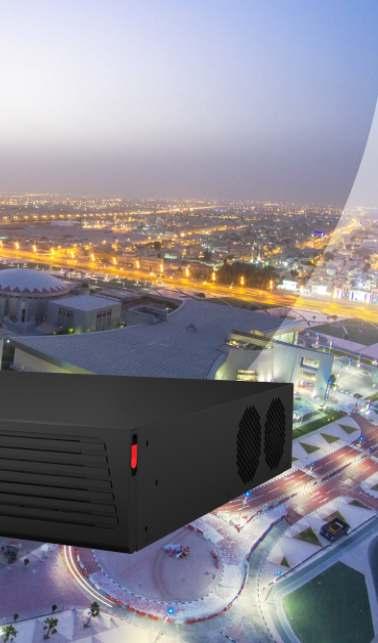
To ensure high-level system stability and data safety, the M-Series NVRs are equipped with an embedded file system that helps to increase productivity for data management tasks, a 1+1 redundant power supply to provide load balancing, reduce pressure, and increase service life, as well as a “dual system” to avoid data loss and guarantee the reliability of the storage system.
To ensure ease of use and simple installation, the 2/4/8/16 bay models of the M Series adopts 1U, 1.5U, 2U, and 3U chassis design. At the same time, the device's hot dip galvanized coating makes it highly durable, and its versatile modular architecture ensures deployment flexibility. These design features bring about a lightweight, hassle free, efficiently heat dissipating device which can easily meet users' evolving needs.
Wenson Zhou, a Product Director at Hikvision says, “The new M-Series NVRs showcase Hikvision's industry-leading technologies and innovations by offering superior quality images of up to 8K super high-resolution through an easy connection with a wide range of Hikvision cameras. These “True 8K” devices will enable users from all kinds of industries with the capacity to zoom into large scenes to view exact details without quality loss.”
In order to turn its auditorium into a multi-purpose venue, and to improve the general visual experience, Dubai's GEMS Modern Academy replaced their legacy projection system with a massive LED wall from Hikvision. The renovated auditorium has become a popular venue for students, staff, and the community

Challenge: Turning the school auditorium into a multi-purpose performance venue With the numerous approaches to entertainment available today, and with audiences' surging demand for rich, high-quality content display and immersive sound and video. As a result, venues such as showrooms, studios, auditoriums, and lecture halls are dabbling in a host of new technologies and applications to achieve the “wow factor” audiences are looking for.
GEMS Modern Academy is one of these venues.
Offering Curriculum to children from kindergarten to grade 12, GEMS is one of the top ten schools in Dubai. Its large auditorium holds 500 seats for school events and can be rented out for private events on weekends. Originally, the auditorium had a large projection screen on the stage to display presentations, images and videos. However, every element in the environment could take away from the image quality, from sunlight coming in through windows to the whiteness of the screen, the distance from the projector, the age of the system, and more.
Ritesh Dhanak, head of the IT team at GEMS Modern Academy said, “The projector system was not good enough with the ambient lighting. In order to create a better experience in our auditorium, and to pave the way for it to become a community hub, we need to do a complete upgrade to our live audio, stage lighting and visual display systems,” To achieve this, Mr. Dhanak worked with Almoe AV Systems,
a renowned distributor and solutions provider of professional audio visual & IT products in the UAE Almoe helped the school to upgrade the auditorium's touch control systems, matrix switchers, stage lighting, and speaker systems. For the most crucial part of the solution – the visuals – they worked with Hikvision to install a new LED display.

The solution: A massive Hikvision LED wall and movable LED side-walls LED displays offer many advantages, including flexibility and modularity. Therefore, the school decided to install a massive LED screen at a width of 12.48 meters, a height of 4.86 meters, and a pixel pitch of 2.5 mm at the center of the auditorium stage. The massive LED wall is made up of nine pieces of P2.5 Fine Pixel Pitch LED Display Units (DS-D4425FI-CAF). The wall delivers an outstanding color gamut and contrast ratio to create remarkably refined images.
For the setup, GEMS Modern Academy preferred to make the two sides of the screen removable to ensure flexibility on the stage, as well as to have multiple videos broadcasted on the screens simultaneously. Four smaller side screens were designed to be 2 meters wide and 5 meters high, with a pixel pitch of 2.9 mm. They were installed on the two sides of the massive center screen. Each side-wall was composed of four P2.9 Indoor Rental LED Displays (DS-D4429RI-CAF). The two side screens are used as backdrops, and can be easily removed when they are not needed.
The LED walls are managed using Hikvision's Video Wall Controller (DS C10S S11T), which supports up to 3840 x 2160 resolution at 30 Hz from multiple signal sources (VGA, DVI, HDMI, SDI, YpbPr, DP, and HDBaseT) This enables the school faculty to easily manage multiple video and audio inputs and outputs.
The benefits: Excellent visual experience for audiences makes the auditorium a popular venue for students, staff, and the community Hikvision's LED wall has vastly improved the visual performance of lectures and events held at the auditorium With an extremely bright and clear image displayed, the screen loses none of its
sharpness, color, or coherence, even when viewed at an angle or when the auditorium is brightly lit “The LED wall provides high quality visuals, and is perfect for our large auditorium,” said Mr Dhanak, “Unlike with the old system, we don't have to dim the lights in the auditorium during lectures, presentations, or live performance, and this allows students to take notes, remain more attentive and, for remote viewers joining via web conferencing, see the auditorium clearly ”
In the end, the video wall displays excellent visuals, adapts to ambient lighting conditions, and offers unique flexibility with the removable side-walls. As a result, Hikvision's LED display solution has turned the auditorium into a venue that fits all kinds of events. Since the LED screens have been installed, the school has hosted a large number of events at the auditorium, such as school lectures, stage plays, and musical performance. In addition, the venue has also been rented out for many private events such as public presentations and speeches.
Impressively, the venue has also been used to host a TED Talk, one of the most popular lecture platforms in the world. Mr. Dhanak concluded, “With a large multi-purpose auditorium providing such excellent visual experience to the audience, events at GEMS Modern Academy are now on a different level and our auditorium is a much sought after event space in the community.”
For more information visit:
The world together spent more than $120 Billion on physical security in 2021. India too is not behind and has a multi-billion dollar thriving physical security industry with around 40 million CCTV cameras operational today. However, despite tremendous technological breakthroughs, security continues to remain late, reactive, limited by human capacity, and expensive.
If we look at the chronology of developments in the physical security space, we started with CCTV feeds in the 1990s where an operator needed to continuously watch the stream But it was realized that human attention is a scarce commodity According to studies, a viewer will miss 95% of screen activity just after 22 mins of continuous viewing To help, motion detection with primary Computer Vision (CV) was innovated in 2000s, object detection with primary AI came in 2010s, and very recently we see research in contextual awareness, that brings computer vision closer to human vision.
But despite clear needs, adoption of technology has been minimal, particularly in India. The demand for innovative breakthroughs that can give people peace of mind is met with a technology supply that is too less for too much. Every second counts in a threat scenario But the best case with Indian customers today is to first wait for the incident to happen, and then if noticed, pull the video if not stolen, and work from there.
This status quo disappoints tech enthusiasts at Quippy, a vision intelligence company founded by ex-Apple engineers with a pedigree from Stanford University and the University of Michigan, USA. They see a clear gap in the supply of technology and consumer demand. A survey reveals that while 95% of consumers want to adopt AI believing AI-based video
analytics provides great value, only 6% of consumers have adopted it. This begs a question - Why? According to them, the reasons are - Affordability, Network Cost, Accuracy, Privacy, and Ease of Use.
“Companies, for lack of innovation, have continued to use out-of box AI inefficiently and lazily, leading to exorbitantly priced, network hungry, hard to use, security risking and poor performing physical security solutions The current market offerings miss fulfilling the core consumer needs and hence do not see serious adoption. While the majority of consumers have not upgraded to smarter options because of infra replacement expenses (buying new cameras, DVR/NVRs, replacing wiring, etc.), some who have opted for smart seeming CCTV cameras complain of missing important events as they happen and being irritated by false alarms and noise. As a result, more than 95% of them turn off these analytics within a month ” says Ayush Gupta, co-founder of Quippy.ai
Quippy feels that they can solve these issues and move the market to a more context-aware framework. They are imagining a world where a trusted, vigilant, smart & fully automatic guard is available to all easily at their fingertips, in an affordable, private and networkfriendly way.
Quippy is now launching its first product in the marketQuippy Hub. Quippy Hub is an edge AI device that retrofits into existing security infrastructure and AI-fies any of your analog or IP cameras within minutes to provide advanced video analytics on-premise. It runs highly optimized state of-the-art AI models with proprietary algorithms that help users get real-time threat detection, prevention, and investigation. It comes with lifetime free access to their mobile app where users can receive important alerts, highlights, and much more. To summarize Quippy offers the following features that uniquely place it in the market -
Users can create their own motion zones with custom time periods to monitor areas like entrance, office
locker, or anything for that matter. This helps them detect and prevent suspicious events while improving premise monitoring. Quippy’s AI algorithms can distinguish between persons, vehicles, animals, etc., and alert when something untoward or of notice occurs. Moreover, as also for other features, users can also filter by day, time, or type of alert and get more insights into events.


Most times, intruders tamper or obstruct the CCTV to destroy evidence. For example, they could disorient the CCTV, turn it off or cover it. Quippy alerts about any such attempt immediately with recorded evidence to catch the criminal.

Quippy hub is smart enough to detect missing objects or people, and alerts owners so that they can take proactive actions. Users can configure the monitoring interval after which they should be alerted. For example, users can ask to be notified if their car is not in parking for more than 10 mins, and an alert is triggered if the car is not seen even once in that interval. Similarly, they can check if the security guard is missing from duty, or if machines are left unattended by operators.


Though people often want to review complete activity on their premise, who can replay 24 hours of video? To solve this, quippy generates smart highlights that wrap up the day in 5 mins for quick review.


“Behind these features are proprietary algorithms and technologies that make our product extremely easy to setup in minutes, provide an intuitive usage, and make the system more context-aware. Each tech has been carefully designed to surprise and delight
the consumers at an impressive cost and network benefits”, says Ayush.

Quippy’s tech stack features some state of-the-art AI models that have been optimized to run on edge such that they can process around 2 crore frames in a day. They have algorithms that try to understand the scene and alert if something new and unexpected has happened, per the security settings added by the user. Same time, users can setup notification intervals so that they are not bothered by alerts all the time, but get the most important ones frequently
Quippy claims to have also solved the major problem of dancing IPs in the local network so that users can operate it easily on edge without using a static IP. They have also imparted ondevice learning where the system improves based on user feedback. Moreover, they have algorithms to pick important events and compress 24-hour activity into a 5 min highlight video for users.



Quippy also claims to have put extra emphasis on privacy. Their system stores most of the user data on-device and un-clouds as much as possible without comprising user experience.



“Privacy is a fundamental value for us. While not much focus is given to it, privacy is important in the physical security industry with many big players getting banned in countries like the US, and the UK over sharing sensitive user data with the Chinese government. Even the Indian government has banned such entities from government projects. We take user privacy very seriously and will continue to do everything possible to ensure user privacy and security”, shares Ayush.

Excited about their forthcoming launch, Ayush says “We are launching in Oct 2022, but have already been doing pilots with various residential places, clinics, and industries. We are glad that we were able to give our customers full awareness about their premises and to have helped them save money by improving efficiency, standards, and in some cases preventing major thefts. We are really looking forward to the launch and hope to give India customers a more peaceful existence.”




SpeedFace-V3L series device is a visible light face access control stand-alone terminal. SpeedFace V3L supports facial recognition and fingerprint. While SpeedFace V3L [QR] supports QR code module, and RFID verification. This series is also equipped with ultimate anti spoofing algorithm for facial recognition against all types of fake photos and videos attack.
SpeedFace-V3L series support IP65 water and dust resistance.
Product Model Display Biometric
SpeedFace V3L
touch Screen Face/Fingerprint
IP65 water and dust resistance
Operating temperature from -5°C to 45°C
Support facial / fingerprint / scramble QR Code / RFID
Available card modules:12.5 KHz ID card / 13.56MHz IC card
Fill Light with adjustable brightness
On Board Web Server for system configuration
Supports up to 500 facial / 3,000 fingerprint / 3,000 RFID card / 200,000 records
SpeedFace V3L[QR] 2.4-inch touch Screen
Only
QR code Bar Code, PDF417(Optional), Data matrix(Optional), MicroPDF417(Optional),
SpeedFace V3L[RFID] 2.4-inch touch Screen /
Ingress
RFID
ID card(Optional),
card(Optional)
ID card(Optional), IC card(Optional)
ID card(Standardl), IC card(Optional)
/ /
Dimensions(L*W*D)
Softwares
05m to 2m
TCP/IP,WiFi(Optional),Wiegand Input/Output,RS485
ADMS, DST, Camera, 14-digit User ID, Access Levels, Groups, Holidays
Anti passback, Record Query, Tamper Switch Alarm, Multiple Anti-Passback
1.2GHz Dual Core CPU, 256MB RAM/512MB Flash, 1MP Binocular Camera
Adjustable LED Fill Light
3rd Party Electric Lock, Door Sensor, Exit Button, Alarm output, Auxiliary Input
12V 3A IP65
o o-5 C to 45 C 10% to 90% RH 185*58.5*20mm
12V 3A IP65
o o-5 C to 45 C
10% to 90% RH 185*58.5*20mm
12V 3A IP65
o o-5 C to 45 C 10% to 90% RH 185*58.5*20mm
ZKBioSecurity, Intelligent Time, easy TimePro
Dimensions (mm)
Intelligent Time,
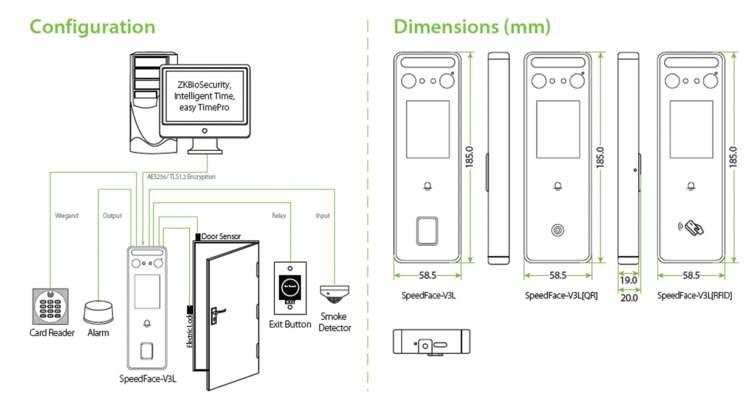
KF1100 series is the innovative visible light facial recognition reader dedicated to InBio series biometric controller to adopt facial recognition technology, offering one of the fastest, most stable, most accurate facial recognition experiences in the industry As a new era biometric reader, KF1100 series is equipped with a 100Mb/s highspeed TCP/IP port for face templates and data synchronization. Wiegand and RS485 (coming soon) available to communicate with InBio Controllers for authentication use. The whole system is compiled with the ZKTeco Cyber Security Base Line (ZKCSBL) to ensure that users' data is under the finest protection that ZKTeco can offer.
• Equipped with ZKTeco visible light facial recognition, offering one of the best facial recognition technologies in the industry
• Supports up to 1,500 facial/30,000 cards/100,000 records
• Supports multiple communication ports, TCP/IP, Wiegand output, RS485 (coming soon), Wi-Fi (coming soon)
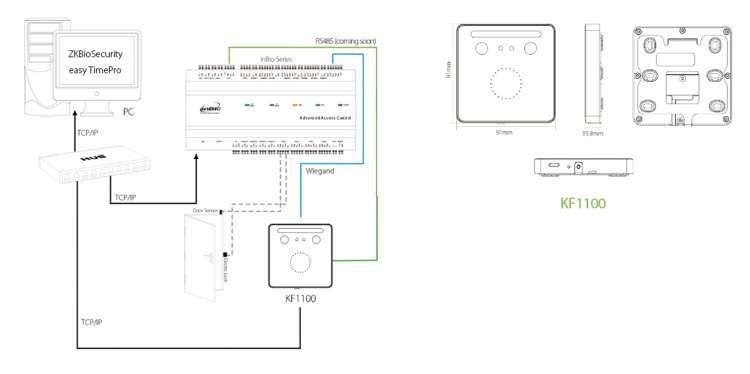
• User-friendly on-board web server for quick system configuration
• Fully compatible with inBio Series controller
• Fully complied with ZKCSBL (ZKTeco Cyber Security Base Line). Standard to provide advance protection
RFID
User Capacity Card Capacity Face Capacity Logs Capacity
Facial Recognition Algorithm
Facial Recognition Speed Facial Recognition Distance
KF1100
Visible light facial ID card standard IC card (Optional) 30,000 30,000 1,500 100,000
ZKLiveface 3.5 < 0.3s
30cm - 50cm
Dimensions (mm)
Offer higher Wire Resolution
True color scanning image
Innovative fingerprint identification
Widely usable for carry on baggage
Steel Penetration
Verification
to 35mm
Fingerprint
Display of Cluttered Bag Images
Metal Detector
Input/Output

Offer higher Wire Resolution with HAMAMATSU® X-ray detector



Pseudo-color scanning image
Widely usable for small parcels
Excellent, ergonomic industrial design
Portable metal detector, convenient to take.
with the Status of the Walk
It can be recharged. It needs 4-6 hours for charging. (standard 9V battery ,the charger and rechargeable battery are ordered additional)
The alarm terms is sound and light alarm simultaneously, or vibration and light alarm simultaneously. You can choose the operate terms optionally
When the low sensitivity on-off is pressed, the metal detector will only alarm when it finds big metal object
Ni-MH Battery and DC charge cable (for option)
18 detection zones
256 sensitivity levels
3.5'' LCD display

People and alarm counting
Synchronous sound & LED alarm


The UAV is an aerial vehicle with no pilot to man controls. They can be remotely controlled by personnel on ground or by pre-programmed flight plans. Of late, the UAVs have become increasingly more sophisticated, and the term UAV has been changed to UAS, an acronym for Unmanned Aircraft System.
The change amplifies the fact that apart from being an aerial vehicle, this complex system includes ground stations, satellite connectivity, sometimes onboard weapons, and other components. Militarily, Disasters, Search and Rescue, Ambulance, fire fighting these systems are gaining tremendous importance, as they can conduct precision strikes, damage on faraway targets without collateral damage Assessment, delivery in time, patient can be carry quickly
Drones offer tremendous benefits to almost all sectors of the economy like –agriculture, mining, infrastructure, surveillance, emergency response, transportation, geospatial mapping, defense and law enforcement etc. Drones can be significant creators of employment and economic growth due to their reach, versatility, and ease of use, especially in India's remote and inaccessible areas.

The earliest attempt to use the UAVs was as aerial targets in 1915. The first operational usage began in 1959 when the US Air Force (USAF) officers commenced planning for unmanned flights to avoid losing trained pilots over hostile territory. This plan gained further momentum when Gary Powers piloting a U-2 spy aircraft aircraft was shot down over the erstwhile Soviet Union in 1960. This propelled a classified UAV programme to be started under the code name Red Wagon.
The UAVs were used in August 1964 in clashes with the Vietnamese Navy in the Gulf of Tonkin. Thereafter, the USAF 100th Strategic Reconnaissance Wing flew more than 3000 sorties during the Vietnam War.
The initial generation of UAVs were primarily used for surveillance. With increased operational requirements they were armed and they became known as Unmanned Combat Aerial Vehicles. (UCAVs). Broadly military UAVs are used for surveillance, direction of artillery fire, gathering Electronic Intelligence (ELINT) information, lasing targets for fighter aircraft and Post strike Damage Assessment (PSDA). Recently it has been used Russia Ukraine war very extensively.
A high-altitude India-made drone being used for reconnaissance at the tense Line of Actual Control (LAC) with China, a joint venture between an Indian conglomerate and an Israeli defence giant operating out of Hyderabad, and a Bengaluru-based drone technology venture acquired by one of India's biggest business houses these are minor glimpses into India's burgeoning, if nascent, private military drone manufacturing industry
In August 2021, new rules for drone technologies were notified by the central government. The 'Drone Rules 2021' form the government's ideational bedrock to catalyse a booming indigenous drone production industry.
The unmanned aircraft system shall, based on the maximum all-up weight including payload, be classified as follows
• Nano unmanned aircraft system: weighing less than or equal to 250 grams;



• Micro unmanned aircraft system: weighing more than 250 grams, but less than or equal to Two kilograms;

• Small unmanned aircraft system: weighing more than Two kilograms, but less than or equal to 25 kilograms;

• Medium unmanned aircraft system: weighing more than 25 kilograms, but less than or equal to 150 kilograms;
• Large unmanned aircraft system: weighing more than 150 kilograms.

• Based on a premise of trust, self-certification and non-intrusive monitoring
• Designed to usher in an era of super normal growth while balancing safety and security considerations.
• Several approvals abolished: unique authorisation number, unique prototype identification number, certificate of manufacturing and airworthiness, certificate of conformance, certificate of maintenance, import clearance, acceptance of existing drones, operator permit, authorisation of R&D organisation, student remote pilot license, remote pilot instructor authorisation, drone port authorisation etc.
• Number of forms reduced from 25 to 5.
• Types of fee reduced from 72 to 4.
• Quantum of fee reduced to nominal levels and delinked with size of drone. For instance, the fee for a remote pilot license fee has been reduced from INR 3000 (for large drone) to INR 100 for all categories of drones; and is valid for 10 years.
• Digital sky platform being developed as a user friendly online single-window system. There will be minimal human interface and most permission will be self-generated.
• Interactive drone airspace map with red and yellow zones shall be displayed.
• No permission required for operating drones in green zones.


• Yellow zone, where ATC permission is required, has been reduced from 45 km to 12 km from the airport perimeter
• No remote pilot license required for micro drones (for non-commercial use) and nano drones.

• No requirement of Type Certificate, unique identification number and remote pilot license by R&D entities operating drones in own or rented premises, located in a green zone.
• Requirement of import clearance from DGCA abolished. No security clearance required before issuance of any registration or license.
• Coverage of drones under drone rules, 2021 increased from 300 kg to 500 kg. This will cover drone taxis also.
• DGCA shall prescribe drone training requirements, oversee drone schools and provide pilot licenses online.
• No restriction on foreign ownership in Indian drone companies.
• Remote pilot license to be issued by DGCA within 15 days of pilot receiving the remote pilot certificate from an authorised drone school through the digital sky platform.
• Testing of Drones for issuance of Type Certificate to be carried out by Quality Council of India or authorised testing entities.
• Type Certificate required only when a drone is to be operated in India. Importing and manufacturing drones purely for exports are exempt from type certification and unique identification number.
• Nano and Model Drones (made for research or recreation purposes) are exempt from type certification.
• Manufacturers and Importers may generate their drones' unique identification number on the digital sky platform through the self-certification route.
• Easier process specified for transfer and deregistration of drones through the digital sky platform.
• Drones present in India on or before 30 Nov 2021 will be issued a unique identification number through the digital sky platform provided, they have a DAN (Device Acknowledgment Number), a GST-paid invoice and are part of the list of DGCAapproved drones.
• Standard Operating Procedures (SOP) and Training Procedure Manuals (TPM) will be prescribed by DGCA on the digital sky platform for self-monitoring by users. No approvals required unless there is a significant departure from the prescribed procedures.
• Safety and Security features like 'No Permission –No Takeoff' (NPNT), real-time tracking beacon,
geo-fencing etc. to be notified in future. A sixmonth lead time will be provided to the industry for compliance.
• Maximum penalty for violations reduced to INR One lakh. It was several lakhs earlier.
• Drone corridors will be developed for cargo deliveries.
• Drone promotion council to be set up by government with participation from academia, start-ups and other stakeholders to facilitate a growth-oriented regulatory regime.
UAVs are great force multipliers and there must be synergy between the three Services to optimise their employment. One good thing which is happening in the recent years is that all acquisitions are cleared by the Chiefs of Staff Committee, rotationally headed by the senior most of the three Service Chiefs, and they work now on common specifications to the extent possible. The resulting coordination is useful.
The UAVs could be employed for multifarious tasks fruitfully, in coordinated tasks.
Presently, the three Indian Services have a rather limited numbers of these aerial vehicles and each Service is looking towards its increasing individual requirements. There should be a phenomenal rise in their numbers in the coming years.
• Digital Sky Platform The Ministry of Civil Aviation launched the Digital Sky Platform, a unique Unmanned Traffic Management (UTM) system which will facilitate registration and licensing of drones and operators in addition to giving instant (online) clearances to operators for every flight. The Digital Sky Platform will enable online registration of pilots, devices, service providers, and NPNT (no permission, no take off).
• Government is working as enabler by creating demand structure for Drones Addressing the session on Drones for Public Good – Mass Awareness Program, organized by FICCI on October 06, 2021, Union Civil Aviation Minister Jyotiraditya Scindia said that the government's role has changed under the leadership of Prime Minister Narendra Modi, and it is working as an enabler, and not a regulator, looking at a new
approach of evidence-based policymaking for drones. Union Civil Aviation Minister said technology promotion is crucial and drone technology will bring those living at the margins to the centre of development. “Drones play a crucial role in connecting the people from the length and breadth of the country.”
• Five Drone Schools to be set-up in Madhya Pradesh Gwalior Drone Mela was organised on 11 December jointly by Ministry of Civil Aviation, Government of India, Government of Madhya Pradesh, Federation of Indian Chambers of Commerce & Industry (FICCI) at Madhav Institute of Technology & Science (MITS), Gwalior. This is part of the series of events planned under the Azadi ka Amrit Mahotsav celebration. The programme was the biggest congregation of drone manufacturers, service providers, drone enthusiasts and user communities, especially students, farmers and common man of the city Programme included drone exhibition, demonstration, drone spardha, industry – user interactions and launches.
Drones have already broken through rigid traditional barriers in industries. Over the past few years, drones have become central to the functions
of various businesses and governmental organizations and have managed to pierce through areas where certain industries were either stagnant or lagging behind. From quick deliveries at rush hour to scanning an unreachable military base, drones are proving to be extremely beneficial in places where man cannot reach or is unable to perform in a timely and efficient manner.
Increasing work efficiency and productivity, decreasing workload and production costs, improving accuracy, refining service and customer relations, and resolving security issues on a vast scale are a few of the top uses drones offer industries globally. Adoption of drone technology across industries leapt from the fad stage to the mega-trend stage fairly quickly as more and more businesses started to realize its potential, scope, and scale of global reach.
Whether drones are controlled by a remote or accessed via a Smartphone app, they possess the capability of reaching the most remote areas with little to no manpower needed and require the least amount of effort, time, and energy. This is one of the biggest reasons why they are being adopted worldwide, especially by these four sectors: Military, Commercial, Personal, and Future Technology.




Small businesses are attractive targets for cybercriminals because they usually lack the cybersecurity precautions of larger organizations. Forty-three percent of all cyberattacks target small businesses, and the consequences of these breaches can be extremely costly, from lost productivity to company reputation. In fact, 60% of all small businesses victims of a data breach permanently close their doors within six months of the attack.
A new study found that 47% of businesses with fewer than 50 employees do not have a dedicated cybersecurity budget. And only 18% of companies with more than 250 employees have a dedicated cybersecurity budget.
The survey found that the average cost of a data breach increased 10% in 2021 to $4.24million. Costs were lower for organizations with more robust cybersecurity policies than organizations with little security infrastructure. The report also found that remote work due to the COVID 19 pandemic increased the average total cost of a data breach. With COVID-19, suddenly companies were using Remote Desktop Protocol (RDP) for remote access. Quite often, MultiFactor Authentication (MFA) was not turned on. This led to a rise in cyber threats, as it was an easy entry point for threat actors. Working remotely
also lengthened the time it took to identify and contain data breaches compared to businesses with more workers back on the worksite.
In many cases, small businesses do not take cybersecurity seriously. Many businesses feel “too small” to be affected by a cyber incident. If an incident does occur, many do not realize the severity of a breach until it is too late. Small business owners do not see the need to invest the time or money in a cybersecurity plan for many reasons, including:
They do not think that they would be a victim of a data breach Budgeting for cybersecurity programs is minimal Systems are outdated and unsupported. Special software needed for outdated devices is no longer supported

During the COVID-19 shutdowns, many small businesses had to switch to remote work, opening these businesses to many cybersecurity issues, from workers using personal computers for work-related tasks to relying on the cloud with little or no IT staff or resources.
Cybercriminals can easily manipulate small businesses. Additionally, these organizations cannot say no to ransomware attacks because they do not have a backup system to recover data if they are attacked.
Human error is the leading cause of data breaches at small businesses. The IBM report also found that compromised credentials were the most common way cybercriminals initially attack a company’s data. Since small businesses do not focus on cybersecurity training, employees can be easily tricked into falling for social engineering scams, malicious threats, or sharing logins, sensitive data and other company and customer information since they do not know what to look for to identify suspicious cyber activity.
According to a survey, 88% of small business owners felt their business was vulnerable to a cyberattack. Yet many companies cannot afford professional cybersecurity solutions or do not know where to start.
A cyberattack is a deliberate assault on a computer system or network that uses malicious code to make unwanted modifications or steal data. Cyberattacks are constantly evolving. Some of the most common examples of cybercrimes include:
Social Engineering Scams: This type of cybercrime deceives or manipulates someone into divulging confidential or personal information for fraudulent purposes. There are many types of social engineering scams, including:
Phishing
Spear Phishing
Baiting
Spoof Websites
Caller ID Spoofing
Smishing
Malware: Malicious software is a type of cyberattack that installs harmful software on a user’s computer after clicking on a harmful link or opening an unknown email attachment. Malware can lock down a computer, block access to files and other critical network components, and obtain sensitive data. Ransomware, a common and highly disruptive type of malware, locks computer files through encryption, until a specific ransom is paid for a key to decrypt the data. Other types of malware are Trojan horses and drive-by attacks.
Attacks: A Structured Query Language (SQL) injection is a cyberattack that involves a hacker “injecting” malicious code into a service that uses SQL, forcing it to expose information it would normally not display, including customer details, user lists and other confidential company data.
Denial-of-Service (DoS): This attack occurs when hackers overload a system’s resources and cause it to become unresponsive to service requests and inaccessible to authorized users.
Botnets: A botnet can drive a cyberattack by using bots to steal personal information, spread spam, and deliver viruses into the computer network.
With cybercrime growing and becoming more advanced every year, it is more important than ever that small businesses understand how these types of attacks can impact their operations and take the proper steps to protect themselves. Early detection of a data breach is critical to saving a company’s reputation and thousands of dollars in damages.
Small business cybersecurity best practices include: Employee Training: Employee cybersecurity training should not be a one-and-done situation. Businesses should consider continuous training to educate all their employees on potential security vulnerabilities, recognizing and avoiding scams, creating strong passwords, and protecting sensitive customer and company information.
Update Security Software: Companies should utilize firewalls, anti-virus software and anti-spyware programs to help ensure sensitive data cannot be easily accessed by hackers. These security programs also require regular updates to keep them free from vulnerabilities, so check any software vendors’ websites to learn about upcoming security patches and other updates.
Protect Your Data: Because many data breaches happen due to employee error, staff should only have access to vital information to their particular role. Companies should consider record retention programs requiring employees to properly purge or archive files. Regularly back up data on all computers and have a recovery system in place if the information needs to be retrieved due to a cyberattack. Segmenting a network is another way to keep from data sharing across the entire network. This way, if a section of the network is compromised, everything is not compromised due to the segmentation.
Password Protection Program: Small businesses and their employees should use strong passwords for every site accessed daily. Passwords should never be shared between employees or written down where others can see them.
Data Encryption: All data via personal devices, computers, or servers should be protected by proper encryption in case there is unauthorized access attempts. When the data is encrypted at rest, it is protected from being viewed unless the user has the proper credentials and code. This is very important for any HIPAA-regulated data.
Multi-factor Authentication: Multi-factor

authentication requires additional verification information, for example, a security code sent to your phone, to log into networks, systems and computers. Wherever possible, it is important to utilize MFA Turning it on for email, VPN access, Firewall, and software access leads to a more secure system.
Cyber Insurance Coverage: Cyber insurance can greatly assist with protecting small businesses from the potential extreme costs that arise from a range of cyberattacks and the financial and reputational damage incurred from data breaches. Cyber claims handlers are there to hold your hand
during the stressful process and help introduce vendors who have been carefully chosen to best assist based on the event.

Ultimately, cybercriminals are trying to get at a person’s or company’s data, and the risk for a data breach at any organization has become increasingly higher. Companies need to be more aware of their cyber threats and be proactive by following specific cybersecurity procedures to help protect their brand, productivity, reputation and customer loyalty.



























Hydrogen can help us enormously to achieve a cleaner, safer and economical energy source in future. But for hydrogen to make a significant contribution to clean energy transitions, it needs to be adopted in sectors where it is almost completely absent, such as transport, buildings and power generation.
At present all the common fuels are extracted either from natural oil or gas. These fuels are limited resources, and their use adversely effects our environment. That's the primary reason, people are looking for alternate fuel (hydrogen) which is renewable as well. It is light, storable, energy dense, and produces no direct emissions of pollutants or greenhouse gases.
Growth in renewable energy production has its own drawback of high Production cost. Hydrogen can be taken out from fossil fuel and biomass, from water, or from mix of both.
When Hydrogen reaches a concentration of 4% to 75%, LEL is highly flammable in presence of oxygen. The amount of energy required to ignite is much lower than other gases.
Hydrogen is a colourless and odourless gas; thus, the leaks are very difficult to identify, and we must take appropriate safety measures to reduce the risk.
Safety Solutions for Hydrogen Leakage:
By installing a Hydrogen Gas Detector and Monitor along with Flame detector the problem of Hydrogen leakage danger can be solved.
Ambetronics provides a range of Hydrogen Gas Detection Systems as per customer's requirements.
It comes in following models:
• Hydrogen Gas Detector: Model GT-2511-FLP
• Hydrogen Smart Gas Detector: Model GT-2500-FLP
• Hydrogen Portable Gas Detector: Model PG-100
• Flame Detector: FLD-3311-FLP
Hydrogen production also comes from water electrolysis; though, currently less than 0.1% globally. With declining costs in renewable electricity, specifically from Solar and Wind energy, industry is showing interest in electrolytic hydrogen.

As we all know about advantages of hydrogen fuel technology, it has disadvantages as well. While hydrogen acts well as a fuel, it will do greater explosion hazard than many other gas fuels.

Ambetronics has very efficient alarming system that alerts whenever the hydrogen concentration goes beyond the permissible exposure limits (TWA: 10% LEL & STEL: 20% LEL).
Want to explore the most suitable Hydrogen detectors and monitors for you? Please connect with Ambetronics Engineers Pvt. Ltd.


Buildings have different kinds of hazards, people with varying levels of mobility, and structures that affect occupants' ability to evacuate in the event of a fire. That's why the National Fire Protection Association's NFPA: 101 Life Safety Code dictates different requirements for three key components of a fire alarm system, among others: what sets it off, how it alerts people in the building, and whether and how it must be monitored for the purpose of immediate response by emergency forces.
NFPA 101 calls these three components “initiation,” “occupant notification,” and “emergency forces notification.” In this article, we explore the various ways that a fire alarm system might accomplish these tasks according to code.
Check out later installments of this series to learn NFPA's requirements for how each different occupancy type – the essential method by which buildings are classified – must uniquely fulfill these requirements.
Initiation, aka how the alarm goes off in the first place, can happen one of three ways: someone sets it off manually, a smoke detector or other automatic detection system triggers it, or an extinguishing system (e.g., overhead sprinklers) sets it off NFPA 101, 9 6 2 1 lays those options out very clearly.
by Arindam BhadraFrom the 2018 edition of NFPA 101 9.6.2.3 A manual fire alarm box shall be provided as follows, unless modified by another section of this Code:
(1) For new alarm system installations, the manual fire alarm box shall be located within 60 in. (1525 mm) of exit doorways.
(2) For existing alarm system installations, the manual fire alarm box either shall be provided in the natural exit access path near each required exit or within 60 in. (1525 mm) of exit doorways.
Be sure to also see Sections 9.6.2.4-5 for guidelines on how far apart manual fire alarm boxes may be placed from one another and from building exits. Also keep in mind that the specific code for your occupancy type most likely has additional requirements for where manual alarm boxes must go. In any case, all manual fire alarm boxes should be easily visible and accessible in accordance with section 9.6.2.7. And even if a building has an automatic detection or extinguishing system, this section still requires there to be at least one manual fire alarm box in the building.
The second type of fire alarm initiation, automatic detection, can come in many forms. For example, some systems detect smoke, while others detect elevated heat or rate of rise, a measurement of how quickly the room temperature is increasing. The code for your specific occupancy will tell you which type of automatic detection system you need (if any). The most common type is the smoke detector, which must be automatic in cases where its coverage is considered “total” or “complete.”
From the 2018 Edition of NFPA 101
Let's begin with manual initiation, which is generally achieved by a manual fire alarm box, also known as a pull station. Section 9.6.2.3 details exactly where these manual fire alarm boxes should be located.
Δ 9.6.2.9 Where a total (complete) coverage smoke detection system is required by another section of this Code, automatic detection of smoke in accordance with NFPA 72 shall be provided in all occupiable areas in environments that are suitable for proper smoke detector operation.
NFPA 72: National Fire Alarm and Signaling Code defines it as coverage that includes “all rooms, halls, storage areas, basements, attics, lofts, spaces above suspended ceilings, and other subdivisions and accessible spaces.”(17.5.3.1) In short, if you have total coverage smoke detection, it should initiate the alarm system automatically
Note: Most occupancies with sleeping units such as hotels, apartments, residential board and care, and others generally have smoke alarms rather than smoke detectors. And smoke alarms, much like in a one- or two-family dwelling, are required to be interconnected to each other within that dwelling unit – but aren't always connected to the fire alarm system.
The third type of fire alarm initiation, extinguishing system operation, is often equipped with automatic detection. In those cases, section 9.6.2.8 dictates that the extinguishing system is configured so that its water flow initiates the alarm.

system's piping, usage in lieu of heat detection devices, and supervision for cases when those elements are required by other parts of the code. Of course, not all fires can be put out or controlled by a typical sprinkler system, so section 9.8 makes provisions for alternative extinguishment systems to be used when a building's contents would fuel one of these types of fires. When these alternative-type systems are used, the code requires actuation of the system to be indicated at a fire alarm panel (9.8.2.1 and 9.8.2.2).
Occupant Notification: NFPA's requirements may not be what you'd expect Occupant notification is exactly what it sounds like: letting people in the building know that they need to get out immediately. There are a few different ways you can do this – and some will work better than others depending on who the building occupants are – but the NFPA provides one basic rule:
From the 2018 Edition of NFPA 101 9.6.2.8 Where a sprinkler system provides automatic detection and alarm system initiation, it shall be provided with an approved alarm initiation device that operates when the flow of water is equal to or greater than that from a single automatic sprinkler. Section 9.7 gives additional guidance for a sprinkler
From the 2018 Edition of NFPA 101 9.6.3.5 Unless otherwise provided in 9.6.3.5.1 through 9.6.3.5.8, notification signals for occupants to evacuate shall be by audible and visible signals in accordance with NFPA 72 and ICC/ANSI A117.1, Accessible and Usable Buildings and Facilities, or other means of notification acceptable to the authority having jurisdiction.
You can look into NFPA 72 and ICC/ANSI A117.1 for more details on installation, but the key takeaways here are “audible and visible signals.” And while that sounds simple, NFPA has a few things to say about just what these signals should entail.
From the 2018 Edition of NFPA 101 9.6.3.7 Audible alarm notification appliances shall be of such character and so distributed as to be effectively heard above the average ambient sound level that exists under normal conditions of occupancy.

9.6.3.8 Audible alarm notification appliances shall produce signals that are distinctive from audible signals used for other purposes in a given building Basically, the nature of audible alarms should be such that you will certainly hear them – whether you are sleeping, whether there is the noise from a crowd, or whatever ambient conditions exist. As for visible alarms, look at NFPA 72, 18.5.3 for details like the required pulse duration and flash rate of strobe lights, and read NFPA 101, 9.6.3.5.1-7 for all the cases in which you don't actually need them.
There's one other method of occupant notification, and that's voice announcements. According to section 9.6.3.9, these should give instructions for how to evacuate the building or relocate to a safer part of it, and they can be either recorded or announced live. See sections 9.6.3.9.1-2 for more details on how a voice announcement should sound and be carried over an existing PA system.
It would be natural to assume that NFPA wants us to notify all occupants every time a fire alarm is triggered, but that's not actually so. NFPA 101 actually allows some fire alarm notifications to occur on a “need-to-know” basis only
From the 2018 Edition of NFPA 101 9.6.3.6.2* Where total evacuation of occupants is impractical due to building configuration, only the occupants in the affected zones shall be initially notified, and provisions shall be made to selectively notify occupants in other zones to afford orderly evacuation of the entire building, provided that such arrangement is approved by the authority having jurisdiction.
Δ 9.6.3.6.3 Where occupants are incapable of evacuating themselves because of age, physical or mental disabilities, or physical restraint, all of the following shall apply:
(1) The private operating mode, as described in NFPA 72 shall be permitted to be used.
(2) Only the attendants and other personnel required to evacuate occupants from a zone, area, floor, or building shall be required to be notified.
(3) Notification of personnel as specified in 9 6 3 6 3(2) shall include means to readily identify the zone, area, floor, or building in need of evacuation
The implication is that sometimes you don't want alarms to cause panic for occupants who aren't able to get themselves to safety, whether that's because of the building's limitations or their own. That's what private operating mode in section 9.6.3.6.3(1) is all about. Check the code for your specific occupancy type to see if private operating mode is permitted in your building
From the 2019 Edition of NFPA 72
3.3.193.1 Private Operating Mode. Audible or visual signaling only to those persons directly concerned with the implementation and direction of emergency action initiation and procedure in the area protected by the fire alarm system.
If you backtrack through the code a bit, you'll see that NFPA 101, 9.6.3.2.1-4 also present many cases where detectors don't have to set off occupant notification, like smoke detectors for elevator hoist ways, closing dampers, and automatic door releases, to name a few. Note that in these exceptional cases, you may only forgo occupant notification if the detector's power supply is monitored by the building's fire alarm system and its activation signals a constantly-attended location. Some occupancies will also allow alarms to run what's called a “positive alarm sequence” in accordance with section 9.6.3.4.
NFPA 72 defines this as “ an automatic sequence which results in an alarm signal, even when manually delayed for investigation, unless the system is reset.” (3.3.205) It allows 15 seconds for someone to acknowledge the signal at the fire alarm control unit before it automatically initiates notification signals and evacuation or relocation announcements (23.8.1.2.1.1(2)). If someone acknowledges the signal within that time, they then have 180 seconds to investigate the premises and either reset the system or confirm the alarm (23.8.1.2.1.1(3)).
Essentially, the alarm can be delayed from notifying occupants for a period of time while someone

investigates the cause of its triggering – an especially handy feature in buildings where occupants may be tempted to set off an alarm when there isn't really a fire.
Fire alarm monitoring ensures that even if no one is in the building when a fire occurs, emergency forces will still be contacted. Typically, monitored alarm systems will have a fire alarm control panel (FACP) installed which transmits any alarm signals to a supervising station. Not all occupancies require monitoring for their fire alarm systems, but those that do are held to section 9 4 6 of NFPA 101, which gives a few options for how to monitor alarms and notify emergency forces.
9.4.6.2 Where emergency forces notification is required by another section of this Code, the fire alarm system shall be arranged to transmit the alarm automatically via any of the following means acceptable to the authority having jurisdiction and shall be in accordance with NFPA 72: (1) Auxiliary fire alarm system (2) Central station fire alarm system (3) Proprietary supervising station fire alarm system (4) Remote supervising station fire alarm system
The most common of these methods, central station monitoring, connects the fire alarm system to a monitoring station via phone line, mobile line, Internet (IP), or another communication medium. Trained staff members then alert emergency services to the facility's alarm signal. Auxiliary fire alarm monitoring works in the same way, except that instead of signaling a monitoring station, the alarm transmits directly to the municipal emergency force's communication center.
Proprietary supervising stations are located within one of the several properties they monitor. This method is for owners of many different properties who want to take care of alarm monitoring themselves. Conversely, facilities with remote supervising station monitoring have alarms transmitted to any location that receives signals from properties under multiple different ownership.
These types of monitoring stations aren't subject to the recording and reporting requirements that govern how central station monitoring services must receive alarm signals. Section 26.3.9 of NFPA 72 details those requirements in full.
However the monitoring is to take place, visible and audible alarms should activate in that station when the system is triggered. If none of the monitoring options above are feasible, the facility may use a different, approved plan for notifying emergency forces. Refer to NFPA 72 for guidance on creating a compliant plan
Another determining factor in how to configure an alarm system is whether your state or city has adopted an edition of the International Building Code (IBC), and which year they have approved IBC requires all sprinkler systems (except for those in commercial kitchens and one and two family dwellings) to be monitored by a supervising station
From the 2018 Edition of IBC 901.6 Supervisory service. Where required, fire protection systems shall be monitored by an approved supervising station in accordance with NFPA 72.
901.6.1 Automatic Sprinkler Systems. Automatic Sprinkler Systems shall be monitored by an approved supervising station.
1. A supervising station is not required for automatic sprinkler systems protecting one-and two-family dwellings.
2. Limited area systems in accordance with Section 903.3.8.
Of course, whether or not your region has adopted the 2018 edition of IBC is far from the only thing that might require you to have your fire alarms monitored. Your occupancy type is the most important consideration in knowing exactly what's required in terms of monitoring, and it determines a good deal of your initiation and occupant notification requirements as well.

Electrical power is no longer a convenience but an absolute necessity. It's how businesses keep the lights on, industries keep running, and households keep food rooms warm and food fresh.
This dependence, along with economic growth, technological advancement, and population increase, has driven a high demand for electricity. And as the size of the electrical market grows, so do the dangers of workplace exposure to electrical hazards.
In reality, almost every single facility has a need for electrical safety, since everyone from maintenance workers, janitorial staff, facilities staff, and equipment operators regularly interact with electrical equipment.
In this article, I'll go over the three pillars of a successful electrical safety program. If your workers face electrical hazards, ensuring their safety will require you to:
• Identify the need for electrical safety
• Verify electrical protective equipment before use
• Comply with equipment testing standards
Arc flash and electrical shock injuries continue to pose a significant threat to workplace health and safety. Anywhere from five to ten arc explosions occur in electric equipment every day in the United States, and as many as ten U.S. workers are killed or injured according to CapSchell Inc., a Chicago based research and consulting firm.
Moreover, the risks associated with shock and electrocution from inadvertent contact with
energized parts have also long been recognized as a danger to workers, and they aren't going away anytime soon (if ever). According to the Bureau of Labor Statistics (BLS), electrocution is the fifth leading cause of workplace fatalities in the United States, with more than 2,000 fatal and more than 24,000 non fatal electrical injuries reported in the last 10 years. Since the BLS counts arc flashes as burns rather than in its electrical shock statistics, the true rate of electrical shocks is even higher
Furthermore, OSHA estimates that 80% of electrically related accidents and fatalities involving “Qualified Workers” are caused by arc flash or arc blast
OSHA rules and the NFPA 70E standard make the use of rubber insulting products mandatory when even the smallest probability of contact with 50 volts AC or higher exists. Regardless of the heavy fines, serious injuries, and deaths that occur from arc flash and electrical incidents, compliance continues to remain an issue. What's even more shocking is that many workers are not using rubber insulating equipment because they simply don't know they need it.
While the best way to prevent arc or electrical incidents from happening is to de energize equipment before beginning work, there are instances where turning off the power could create an even greater hazard. As such, employers and facility owners must establish safe practices to protect their workers against arc flash incidents, including guidelines for the proper use of Personal Protective Equipment (PPE).
Rubber insulating products, such as the gloves, blankets, sleeves, line hoses, and hoods used by electrical workers today, are manufactured in accordance with industry consensus specifications under the auspices of the American Society for Testing and Materials (ASTM). These ASTM standard specifications are referenced in the OSHA regulations dealing with electrical safety, specifically 29CFR1910.137 covering Electrical Protective Devices, and 29CFR1910.269 covering Electric Power Generation, Transmission, and Distribution.
Bear in mind that rubber gloves are the only protective gear designed for constant contact with, and protection from, energized conductors and equipment. All of the other items are designed for protection from accidental, incidental, or brush contact.
Take care to choose the correct rubber insulating glove for the task at hand and level of electrical exposure. Rubber insulating gloves are typically manufactured in sizes 8 to 12 (often in half sizes), although options in sizes 7 and 13 are available from some manufactures. In addition, rubber insulating gloves are available in different cuff lengths of 11, 14, 16 and 18 inches depending on the glove class.Rubber insulating gloves are available in six specific voltage classes (Class 00 to Class 4). Other rubber insulating products are available in different voltage classes as well.
There is a significant margin of safety between the proof test voltages and the maximum working voltage. Gloves and other rubber insulating products must be permanently marked to indicate the voltage class, and the gloves and sleeves must also have a colorcoded label identifying the voltage class.
OSHA and ASTM standards also require regular inspection of

in-service electrical protective equipment in order to maintain compliance and ensure the products' safety and integrity when exposed to a wide range of voltages.
Visually inspecting rubber gloves and sleeves identifies physical, chemical, or ozone damage Inspecting under direct light is recommended because it enhances the ability to see surface imperfections on the rubber Inflating the gloves with air or otherwise stretching the surface helps identify age and ozone damage as well as other physical damage such as snags, rope burns, deep cuts, and punctures.
Expand the gloves no more than 1.25 to 1.50 times their normal size.
Listen for escaping air to detect holes. If a portable inflator is not available, use a rubber glove inspection tool or roll the glove cuff tightly to trap air inside. Then, apply pressure to areas of the glove to inspect for escaping air. Repeat the procedure again with the rubber gloves turned inside out.
All rubber insulating equipment should be thoroughly inspected prior to use. Common problems to look for include the following:
1. Cracking and Cutting –Prolonged folding or compressing can cause this type of rubber damage.
2. UV Checking – Storing in areas exposed to prolonged sunlight causes UV checking.
3. Chemical Attack – Oils and petroleum compounds can cause swelling of the rubber.
4. Avoid Folding – The strain on rubber at a folded point is equal to stretching the rubber to twice its length.
5. Snags – Wood, metal splinters and other sharp objects can snag or tear rubber.
6. Physical Damage – Rope burns, deep cuts, and puncture hazards are cause for rejection.
Various ASTM Manufacturing and Acceptance standards mandate the testing of the rubber insulating products by the manufacturer or supplier prior to the first delivery to the end user.
Users also have the option of performing or requiring an acceptance test upon receipt of the goods and prior to placing rubber insulating products into service. Once placed in service, there are periodic re-test intervals specified in the following ASTM standards:
• ASTM F496 Rubber Insulating Gloves –6 months (under very limited conditions this can increase to 9 months)
• ASTM F496 Rubber Insulating Sleeves –12 months
• ASTM F479 Rubber Insulating Blankets –12 months
• ASTM F478 Line Hose & Covers – when field inspection or company policy warrant
Note that these in-service re-test intervals are the maximum permitted and must be performed in addition to daily field care and inspection. It is quite common for users, including power utilities and contractors, to specify shorter intervals. Do not, however, place rubber insulating products into service unless they have been electrically tested within the previous 12 months.
Rubber goods should be electrically tested at their rated test voltage using specialized equipment designed to gradually increase the voltage to the desired test level. The dielectric test is two-fold:
• Pass/Fail on the ability to withstand the rated test voltage
• For gloves, quantitative on the ability to prevent electric current from passing through the rubber gloves above the maximum listed in the specifications
Products that pass the inspection and test procedures can then be returned to service.
Testing is a critical component to electrical safety –not only does it help maintain compliance, but it
also increases savings. Rubber insulating products are costly, and these costs are often unnecessarily increased by purchasing replacements for products that could have remained in service with the proper testing and re certification.
If you don't have the equipment required to perform these electrical tests, there are independent testing facilities that can perform the acceptance and inservice testing on behalf of end users. ASTM standards recommend that the inspection and testing process include the following steps:
1. Check in
2. Removing previous testing markings
3. Washing with cleaning agents that will not degrade the insulating properties
4. Visual inspection (inside and out)
5. Electrical test
6. Final inspection
7. Record-keeping
8. Marking
9. Packing in appropriate containers (to prevent folding, creasing, or similar stress on the rubber) for storage or shipment
When selecting a test lab for use, make sure it is NAIL (National Association of Independent Laboratories for Protective Equipment Testing) accredited. NAIL provides the only Laboratory Accreditation for electrical equipment test labs in North America
Nearly all industrial workplaces have a need for electrical safety, and failure to comply can result in heavy fines, serious injuries, and even death. OSHA and ASTM standards also require regular inspection and testing of in-service equipment in order to maintain compliance and ensure the products' safety and integrity when exposed to a wide range of voltages.
Fortunately, there are practices that you can easily implement into your electrical safety program to help you prevent injuries, avoid citations and penalties, and curb superfluous spending. It starts with awareness of the need for electrical safety, and includes visual inspection as the first line of defense for your electrical safety products with periodical re-testing for continued confirmation of the equipment's effectiveness.

Unlike safety glasses, goggles provide a seal between the PPE and the face. That seal keeps contaminants from reaching the eyes, which provides greater protection from fine particles and splash risks.
If goggles are the right choice for your team, you'll have at least one more decision to make. There are three basic classes to choose from depending on the nature of the work.
Would it surprise you to learn that thousands of people are blinded due to work-related eye injuries each year? Dig a little deeper and you'll find that the total annual cost of eye injuries tally up to more than $300 million.
Most of these injuries are preventable. In fact, eye injuries generally occur because workers are either wearing no eye protection or the wrong safety eyewear for the kind of job they're doing
This, despite the fact that OSHA requires eye and face protection when there is a chance of exposure to eye or face hazards. Basically, everything from flying objects to chemicals and countless scenarios in between.
Would it surprise you to learn that thousands of people are blinded due to work-related eye injuries each year? Dig a little deeper and you'll find that the total annual cost of eye injuries tally up to more than $300 million.
Most of these injuries are preventable. In fact, eye injuries generally occur because workers are either wearing no eye protection or the wrong safety eyewear for the kind of job they're doing.
This, despite the fact that OSHA requires eye and face protection when there is a chance of exposure to eye or face hazards. Basically, everything from flying objects to chemicals and countless scenarios in between.
However, there is a gap between the lenses and the face, meaning fine particles or chemicals could still reach the eyes. Depending on the type of work your team performs, you may need to upgrade to safety goggles.

• Indirect-Ventilation goggles are best for working with acid and chemicals, degreasing, and high temperature tasks. Their angled, vented parts provide air flow without giving foreign objects or contaminants direct access to the eyes.
• Direct-Ventilation goggles, as the name suggests, include front facing vents. Since ANSI standards require these goggles to deflect spherical items with a diameter of 1.5 mm or larger, direct ventilation goggles offer the best protection against foreign particles and debris However, the frontfacing vents still leave an opportunity for chemicals and other toxic liquids to splash up into the face and eyes
• Closed-Vent goggles have no vents but provide the greatest level of overall protection from everything from debris to chemical splashes.
When your goal is safety, you want your team to be compliant and actually wear the proper gear. That means taking into consideration not only the safety features but also the additional challenges your team may face when wearing PPE.
Fogging Airflow can be problematic in hot or humid

Respirators play an incredibly important role in worker safety by preventing exposure to potentially harmful air contaminants such as dusts, fumes, gases, smoke, and vapors. But in order to work effectively, respirators must be in good condition and for reusable respirators, that means receiving regular cleaning and maintenance.

Manufacturers recommend that you clean your respirator after each use. While it may be tempting to use cleaning wipes, this method isn't sufficient and should only be used in the interim, like after a quick break or lunch.
To properly clean your respirator, follow these steps:
1. Remove the Cartridges and Filters. Do not wash them, as they should not become wet or damp.
2. Clean the Facepiece. Immerse it in a warm (not hot) cleaning solution and use a soft brush to scrub it until clean. While adding a neutral detergent is fine, never use cleaners containing lanolin or other oils.
3. Disinfect the Facepiece. Soak the clean facepiece in a suitable disinfectant solution, such as quaternary ammonia disinfectant or dilute sodium hypochlorite. Rinse the facepiece in fresh, warm water and allow it to air dry in a clean area.
4. Inspect the Respirator Components. Before reassembling the respirator, inspect every part to ensure it's free of damage or deterioration. This includes the facepiece, inhalation and exhalation valves, head straps, plastic parts, and cartridges and filters.
5. Reassemble the Respirator. Store in a clean, dry place away from contamination when not in use.
These steps do not apply to disposable respirators, which should simply be thrown away after each use. If you are sharing a respirator with other employees, it's particularly important that the respirator be cleaned following this process after every use.
Beyond regular cleanings, it's critical to conduct ongoing maintenance for your respirator. Primarily, this involves inspecting the entire respirator to look for damage, wear, or deterioration Consider the following checklist as you inspect your respirator.
Warping
Dirt
Holes, tears, or cracks
Stiff rubber/silicone
Cracks that may result from the respirator bending
must be present
valve cover
Tears
with
or other

Replace your filter and cartridge regularly according to a predetermined "change out' schedule." Date all cartridges and filters when you put them in, and never use one that is an unknown age.
• Work involving fast movement or heavy labor requires more air to move through the filter and results in a shorter service life
• Low concentrations of contaminants increase service life
• High humidity (above 85%) decreases service life by about 50%
It's fine to conduct simple maintenance, such as replacing a valve or clamp, by yourself. For more complicated repairs, however, it's important to delegate the work to a qualified person. Often, the manufacturer will do this work.
Don't handle your respirator with dirty hands. You spend time cleaning and disinfecting your respirator, so wash your hands prior to handling it.
Never stretch your respirator over the top of
a hard hat. This can warp the facepiece and stretch the straps, affecting its fit and effectiveness.
Do not fold your respirator (unless it's made to be folded). Folding creases the filter and can affect its ability to form a proper seal on the face.
Store your respirator in a sealed bag. This stops the cartridges from absorbing contaminants when not in use and keeps the respirator clean and free of dust.
Always use the correct cartridge and filter. Using the incorrect cartridge or filter can not only limit the life of those components, but can cause health issues. If you're not using the right parts, you may not be protected from the hazards in your workplace.
If taken care of properly, respirators can last a long time. Filters, on the other hand, must be changed fairly regularly according to the manufacturer's recommendations. If you have further questions about how to clean, inspect, or maintain your respirator, don't hesitate to reach out to a qualified professional or to the manufacturer
Cont. from Pg. 48
conditions. Consider the ramifications of fogged up lenses: missteps leading to falls, lost peripheral vision leading to bumps or even being struck by a projectile There are special coatings and dual lens options that act as fog deterrents.
Safety eyewear behaves a lot like regular eyeglasses, and you can get a lot of the same features for your PPE that you would for your prescription lenses. Consider scratch-proofing the lenses, coating them to limit the effects of eyestrain, and possibly even tinting them for tasks that expose workers to glare (like outdoor worksites and welding). Lenses for safety glasses can also be made to conform to an employee's prescription to avoid having to wear a pair of glasses underneath their eyewear.
Who wants to wear PPE that is painful or irritating,
especially to something as sensitive as the face? Make sure your'e getting the proper fit to avoid undue pressure or irritation.
These options fall somewhere between safety glasses and safety goggles. Combining the look and feel of glasses with the seal of goggles to protect against dust and fine particles, this is an option for some jobs. However, because the seal is foam-based, chemicals can soak through it and reach the face and eyes.
Sight is crucial for most jobs. Making sure the eyes are safe is critical to protecting your employees' quality of life and continued ability to work. So make sure you equip them with safety eyewear that protects them from all of the eye hazards they face.

Lockout/Tagout (LOTO) is a safety protocol that establishes minimum requirements for identifying and blocking hazardous energy during the maintenance or servicing of industrial equipment or systems.
A lockout device is applied to physically prevent the transmission of energy. A tag or label is then attached to the lockout device to identify the authorized worker responsible for the lockout, the date and time of the lockout, and any pertinent visuals and safety information.
The best form of lockout is a physical barrier or gap, such as removing cables or installing a blind flange to eliminate any chance of danger. The least effective form of LOTO is a simple warning tag. Tagging out by itself is not recommended and is used only when it is impossible to lock out the energy source. Tags used without a lockout can require additional measures, such as physically blocking the control switch.
Hazardous energy refers to any energy that has the potential to cause injury or damage, including electrocution, burns, asphyxiation, and death.
The most common forms of hazardous energy are electrical, chemical, thermal, pneumatic, and mechanical.

Implementing LOTO in chemical plants is focused on isolating energy in the processing and piping system, using bank flanges and slip blinds. A chemical plant LOTO deactivates process systems and emphasizes the de-pressurization of the piping network and removal of all contents.
All lockout devices used in this procedure must be standardized, documented, and clearly identifiable. Many petrochemical plants augment their LOTO procedure with a work permit system that identifies the equipment to be serviced and any procedures specific to the equipment, system, or chemicals involved. A simple LOTO procedure for pressurized liquids and compressed gasses requires:
• Shutting off and locking out either with built-in devices or peripheral attachments
• Tagging valves
• Bleeding off excess gas and liquids
• Clearing lines
Hazardous energy control procedures for chemical plants require specific LOTO protocols in comparison to lockout actions related to other equipment and machinery.
Provide LOTO training to employees, including mock drills to simulate particular situations. Ensure that the procedures and lockout devices are documented.
Determine the task at hand, staff requirements, and risks involved.
Notify all affected employees that the piping network and process system is being serviced or maintained and that LOTO procedures are in place.
Provide a specific lockout procedure for each type of maintenance or potential emergency, including a checklist of lockout points.
Use a system of worker-assigned locks, including bland flanges and slip blinds. Tags must be securely attached to all lockout points, clearly indicating deactivation, danger, and do-not operate instructions. It is crucial that all lockout/ tagout resources identify the responsible worker and supervisor.

Once the processing system or piping network has been isolated and locked out, an attempt to restart the equipment should take place to confirm that there are no secondary sources of energy. Qualified personnel must verify that all energy is locked out of the system.
Ensure that all stored energy is released or neutralized, including electrical, pressure, fluids, gas, and mechanical. After all tags and locks are installed, the equipment and systems should be tested to make sure they are no longer in operation. All gases and fluids in isolated piping networks and process systems should be depressurized, emptied, and decontaminated.
Notify all affected workers and provide specific
instructions in the event of a shift change while equipment is still locked out. Substitute locks belonging to a leaving shift with the locks of the arriving shift.
As system operation procedures change over time, it will be necessary to evolve your LOTO procedures alongside them.



Make sure there are specific steps in place to recommission the piping network and process system. Include protocols that outline a process for the removal of tags and locks, and that startup is supervised by qualified personnel.
(Find out who's allowed to unlock equipment that's been locked and tagged out.)
The OSHA standard for The Control of Hazardous Energy (Lockout/Tagout) 29 CFR 1910.147 provides the flexibility to suit the particular energy control needs of the specific equipment and industry
According to OSHA, the successful implementation of lockout/tagout procedures in accordance to this standard prevents more than 100 deaths and 50,000 injuries annually. OSHA also points out that workers injured from hazardous energy sources are away from the job for an average of 24 days recuperation. This alone makes LOTO an essential component of any industrial safety program.
material like swarf in machine shops. Lacerations on hands are so common that cut-resistant gloves have become an increasingly standard requirement on work sites.

The Department of Labor reports that cuts to hands or fingers are the second most common type of reported injury (back is still king). Hand injuries accounted for 23% of injuries reported, and OSHA estimates that 70% of those injured were not using gloves, while the remaining 30% had inadequate gloves. These aren't trivial numbers. They add up to hundreds of thousands of incidents. So knowing how to select proper gloves is imperative.
Giving workers gloves made from the wrong materials puts their hands at risk and increases the likelihood that they'll remove their gloves while hazards are still present. Strong, precise, adaptable, but also fragile – hands are our number one tool. Workers' hands, however, are exposed to all manner of hazards on the work site. Proper protection is a must.
There are a variety of rigorously tested and rated glove materials being created and combined in innovative ways to meet the demands of different kinds of work. The right pair of work gloves can mean the difference between an “oops” and a severe injury, but with so many types available it isn't always easy to figure out exactly what type of glove you need for what type of work.
Trying to understand the rating systems can be a little daunting. With materials types and trade names, ratings and brands, things can get out of hand. This general overview of what it all means is meant to help you navigate the vast selection of safety gloves available on the market.
Sometimes your task finds you working with sharp edges like tools and blades, jagged edges, or cut off
Designs and materials are many and varied, with some gloves uniquely designed for specific, individual tasks. For example, those working with certain chemicals may choose butyl gloves over latex or nitrile for their lower chemical reactivity.
Most workers, however, don't have such prescriptive tasks and need gloves that can protect their hands in a range of situations. General purpose protective gloves are usually made of a tough fiber with a good cut resistance and a gripping surface that is also resistant to chemicals and moisture. Lacerations are the main category of injury, but what about punctures, abrasions, chemical burns, and heat burns?
The American National Standards Institute (ANSI) and the International Safety Equipment Association (ISEA) standard 105 lays out guidelines for how gloves should resist abrasion, cutting, tearing, and puncturing. and lays out a framework for rating gloves according to performance.
Using the American Society for Testing and Materials (ASTM) F2292-15 standard test method, a tomodynamometer (TDM100) uses a straight blade and side-to side cut to measure material resistance to a controlled cutting action at variable pressure. Based on the performance in this test (i.e. the weight load needed to cut through), an ANSI cut score of A1-A9 is assigned to the material.
The European standard EN388, although similar, uses a slightly different approach called a coupe test. A progressively weighted rotating blade is applied to fabric
until it breaks through and determines the force needed. This method has a weakness, however. If the test material is sufficiently resistant, it will dull the circular blade and a specific alternate approach has to be used. In this case, the ISO 13997 test standard takes over, utilizing the same TDM-100 machine as the ANSI method. Based on the cut-through force required in Newtons, the material is given an EN388 cut resistance letter score from A-F.
Of course, cutting edges aren't the only hand hazard we encounter on sites and the requirements aren't one size-fits-all. Gloves may have to resist other types of mechanical damage like puncture and abrasion, as well as chemical permeation and degradation, heat and flame resistance, vibration resistance… the list goes on. ASTM has devised and standardized test methods for each resistance criteria, so an informed selection can be made based on the identified hazards of the work in question.
A given worker might be exposed to chemicals but no sharps. Depending which chemicals are in use, simple butyl rubber, nitrile, or neoprene gloves may work well. Other workers may not work with many chemicals at all but protection from vibration or abrasion may be especially important. Workers may spend a lot of time outdoors, where protection from the cold is more relevant than heat resistance. The needs vary drastically from one application to the next.
Whatever your work has you doing, thoughtful selection of gloves can help ensure tasks with novel hazards aren't putting hands at risk. For example, a 2016 addendum to the 105 standard added a test method for rating resistance to hypodermic needle puncture an important criteria to sanitation and medical workers.
PPE selection has to consider the type of work and both ANSI and protective glove manufacturers have made an effort to be comprehensive in addressing hazard categories.
For all of the complicated ratings and measurements, none of it is any good if the gloves are too stiff and restrictive to use.
If they are too thick or coarse to allow for reasonable dexterity, you'll see them getting removed constantly and risk adding to the 70% of hand injuries in which a worker was not wearing protection. If gloves don't let the worker perform their task effectively, the purpose is utterly defeated. So, while
protection is a priority, they must also be made of materials that are practical. Properties like tactility, dexterity, weight, warmth, wicking, and comfort help ensure the gear will be worn, so the material they are made from is especially important.
So, what materials are today's protective gloves made from? Ultra-high molecular weight polyethylene and similar synthetic materials are used as a liner in a number of products. It's an extremely tough synthetic thermoplastic that can resist mechanical damage (15 times more resistant to abrasion than carbon steel!) and as a bonus, has a good resistance to acids and alkalies.
Aramid (aromatic polyamide) and Kevlar are alternative materials that make ideal glove liners due to high cut and chemical resistance and have the added benefit of being light and quick drying.
The outer shell is the main body of the glove, and different fabrics may be layered to cater to specific needs. Synthetic or natural leather, or alternatives such as elk skin, deer skin, pig skin, or goat skin is often used for tasks like welding where heat and flame resistance are the main hazards but dexterity is still important.
Extra layers of synthetic or natural fibers can be added to improve cold resistance. Molded TPR (thermoplastic rubber) material might be added to the back of gloves to offer impact protection for heavy duty environments such as oil rigs. The composition of the outer layers tailor the glove more specifically to the hazards of the task.
Finally, the gripping surface needs to have some additional properties while supporting the overall protection level of the gloves. The palm and fingers are often covered in a crinkle-textured, flexible coating such as latex or nitrile that can channel away moisture and allow for grip even when wet. These layers can even offer enhanced cut and abrasion resistance depending on the material.
If OSHA is right and most, if not all, of the 110,000 annual lost-tine hand injuries in the U.S. are due to workers not wearing hand protection or wearing the wrong protection, that means the number could be reduced to zero (or close to zero) just by providing workers with the right PPE
That can be a bit daunting, but selecting the right gloves is far easier with a bit of basic knowledge in hand.
Ambetronics Engineers Pvt. Ltd., indigenous manufacturer of gas & flame detectors, gas analysers & process control instruments, clean room monitors, cold chain monitoring solutions & industrial automation solutions since last 31 years, are proud to announce that it has become the winner of Innovation Awards 2022 under the category “Fire Fighting Equipment & Health and Safety Equipment, Made in India”.
Ambetronics received number of awards in different categories:
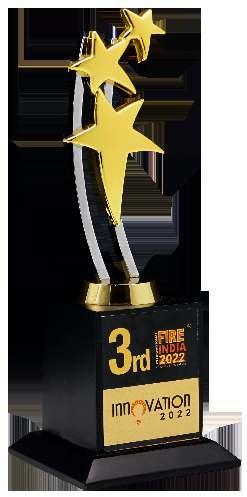
• Fire Fighting Equipment
• Health & safety Equipment
• Passive Fire Protection
• Other Detection Equipment
Innovation Awards are annual awards held in Fire India Exhibition which is organised by "Services International & Indian Institute of Fire Engineers (India). Fire India is the Asia Largest Fire & Safety Exhibition, it recognizes companies which are developing solutions that will benefit the fire safety, life safety, disaster management, and unmanned aerial vehicle (UAV) industries and enable users or industry to do a better job.
"Ambetronics trusts to innovate new products to ensure protection of people and property from any industrial/residential gas leak or fire hazards." said Mr Ashish Shah - MD, Ambetronics Engineers Pvt. Ltd.
Ambetronics is the leading company in India which has indigenously manufactured and successfully launched Series of Gas & Flame Detectors. These detectors effectively detects flame and smallest leakage of Flame, Toxic, Combustible or asphyxiant gases on gas pipelines, tank farms, oil and gas industries, etc. The weatherproof and Flameproof enclosure of gas detectors makes it suitable to be used at any hazardous locations.
"This recognition boosts our morale to keep up and work even harder to contribute towards fire and gas leak safety " saidMr RaviShah Director,AmbetronicsEngineersPvt Ltd

Safe thMagazine Co-organized first time Industry forum on 6 Sept at Infocomm, B.E.C., Mumbai. This wasSecure the first time for the Safe Secure Magazine team co organizing the forum. Ms. Yogita Mundhe (MD & Editor) was the co organizer of the seminar



The session started at 2.00 pm. in presence of dignitaries.
The session started with welcoming the Keynote Speakers Mr. P. C. Sinha, IG Cum Chief Security Commissioner, Western Railway, deliberate upon topic “Planning Considerations for Government Installations.”
Mr. Shankar Jadhav, Managing Director, BSE Investments Ltd; Head of Strategy, Bombay Stock Exchange who deliberate upon topic “Planning Considerations for Large Public Area”
Followed by the Panel discussion on Planning Considerations for Large Public Areas like Hotels Focal points:
• Design, implementation, technology and maintenance aspects for security for the future.
• 360-degree approach to the concept of Security – physical, cyber and procedural breaches.
• Key learnings and way forward.
Moderator for Panel Discussion Ar.Shrreyash Sarmalkar Founder, Principal Architect & Project Management Consultant @ ESSQUARE
Followed by the Panelist Mr. Apoorv Pareek, Director of Loss Prevention, Hotel JW Marriott, Dr. Mukta Girdhar, Director, Disaster Relief Foundation, New Delhi, Cdr. Vikas Wilson (Retd), Chief Security Officer, Trident Hotels & Major Manish Kar, Loss Prevention Manager, Hotel ITC Maratha.
The explanation and the Panel discussion was superb. They deeply explained why security and what are the importance of the security.
Detailed the concept of the security at the public areas. As people don’t even bother what kind of security we are looking at. As the session went smoothly explaining the importance of the Signage’s and also the things which are ignored while moving around the public areas. Dr Mukta also explained about the Disaster and Natural calamities which occurs. How people should know the basic and that should be mandatory by the Government for all the schools, societies and factory to make training programme to teach them how to survive during the time of emergency. So that we can at least cut the count of the death as we cannot hold the natural calamity.
Lastly all the dignitary were facilitated by distributing the trophies as a token of appreciation.
Special Thanks to Sooraj
show.























A Huge Success and India's Premier Fire Safety Exhibition. Event turned the meeting point for the Fire Fighting and Fire Protection Systems Industry.

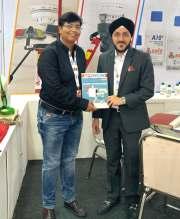







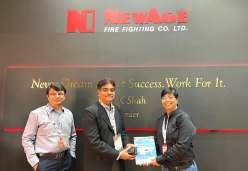













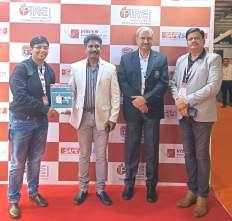














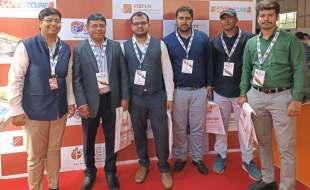

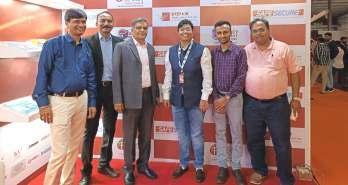











Jaipur, the capital city of Rajasthan, steeped in history and cultural heritage, is steadily becoming the hotspot of Industrialization and one of the main metropolitan provinces of the country, thus infusing the need for advanced security measures for sustainable socio economic progressiveness.
Accentuating these aspects in the long run, ZKTeco India has organized an event on 20th August 2022 in view of addressing these radical transformations in the pink city of India towards one of the fastest developing metropolises concerning implementation of Smart Security ever since the country has set its eyes towards international competitiveness and involved in numerous infrastructure projects such as Smart Cities Mission, National Highway Expansion, and Rapid Transit Projects to name a few.
The event exemplified the vision of futuristic advancements in Biometrics and Intelligent Security Management pertaining their vital roles in systematic urbanization through technology integration capabilities, thereby establishing a safer, secure, and modern community as the security technologies complement stable social developments.
Envisaging the rapidly proceeding technological innovations in these domains, illuminates positive impacts on public security and serve as a leverage for shaping the future and as the India's leading manufacturer of Biometric Products & Electronic Security Solutions, we are privileged to be a part of this incredible phenomenon.

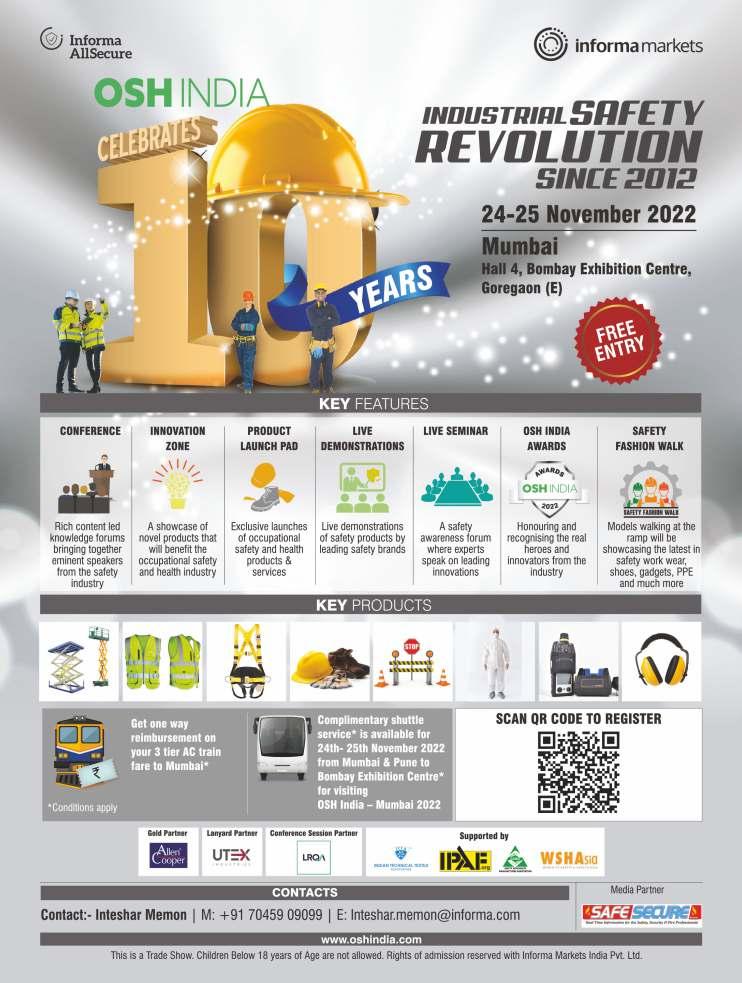
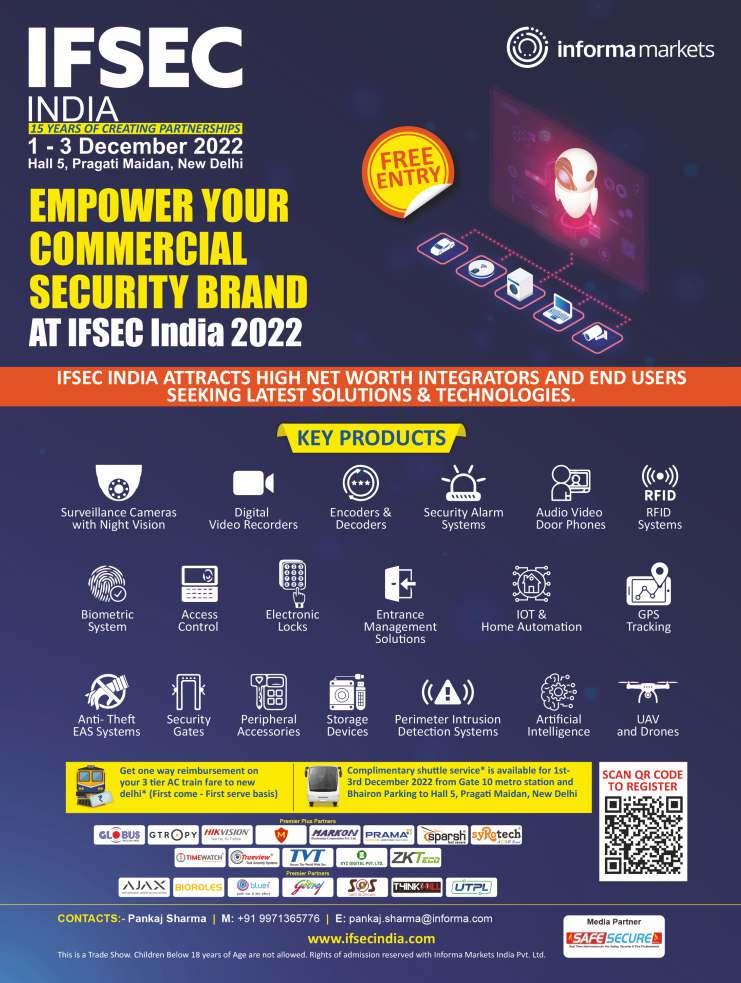






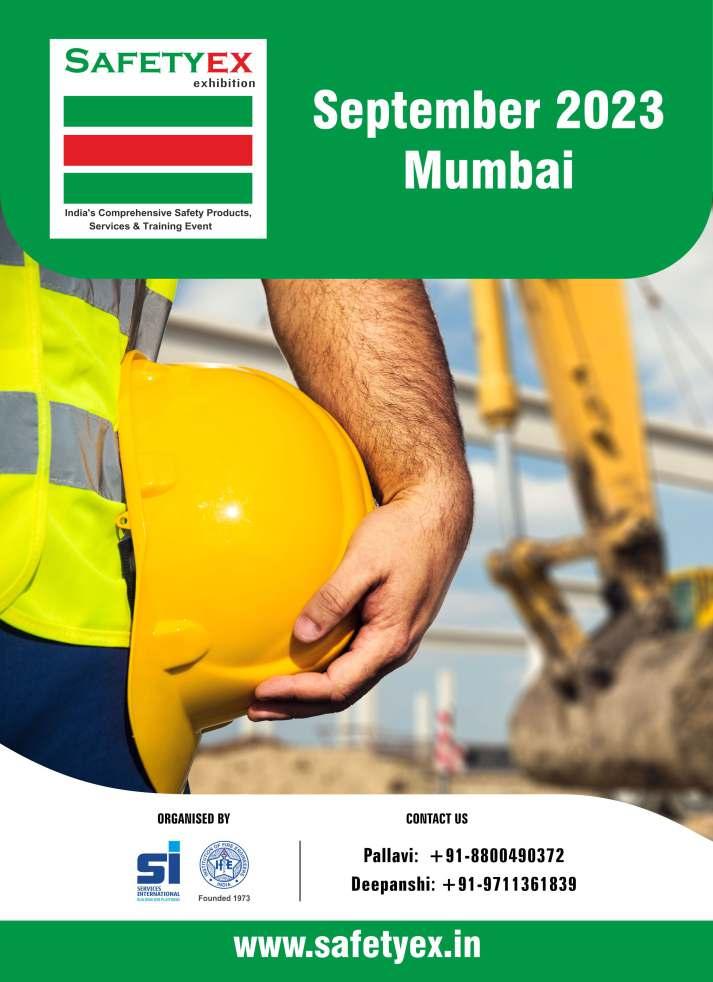










ADVERTISER’S
AV INTEGRATION COMMUNICATION NETWORKING EXPO (AV-ICN) 2023
DEEPTRONICS
DETNOV SECURITY SL
DHREEYA ELECTRONICS LLP
ENGINEERING EXPO 2022 & 2023
FIRE & SECURITY INDIA EXPO 2023
FIRE ALARM & AUDIO SYSTEMS (APOLLO)
FIRE INDIA 2023
IBEX INDIA 2023
IDAC 2023
IFSEC INDIA 2022
ISHA ENTERPRISES
KEMEX INTERNATIONAL PVT. LTD.
KIAAN INDUSTRIES PVT. LTD
LAKELAND GLOVES AND SAFETY APPAREL PVT. LTD.
LIBERTY SHOES LTD.
MARITIME OCCUPATIONAL HEALTH & SAFETY SUMMIT 2023
MARVEL GLOVES INDUSTRIES
NEWAGE FIRE FIGHTING CO. LTD.
OSH INDIA - MUMBAI 2022
QUIPPY INNOVATIONS PRIVATE LIMITED
RESQ TECHNOLOGIES

SAFETY APPLIANCES MANUFACTURERS ASSOCIATION (SAMA)
SAFETYEX 2023
SHAH BHOGILAL JETHALAL & BROS.
UDYOGI PLASTICS PVT. LTD.
VICTOR IMPORTS
VIGHNAHARTA TECHNOLOGIES PVT. LTD.
VINTEX FIRE PROTECTION PVT. LTD.
